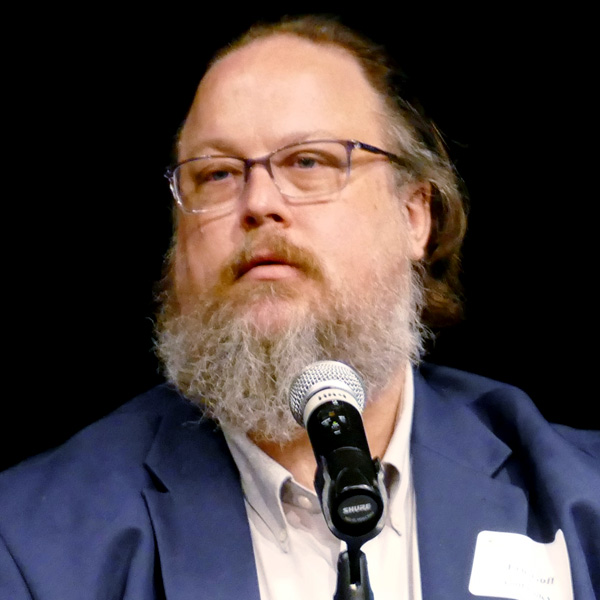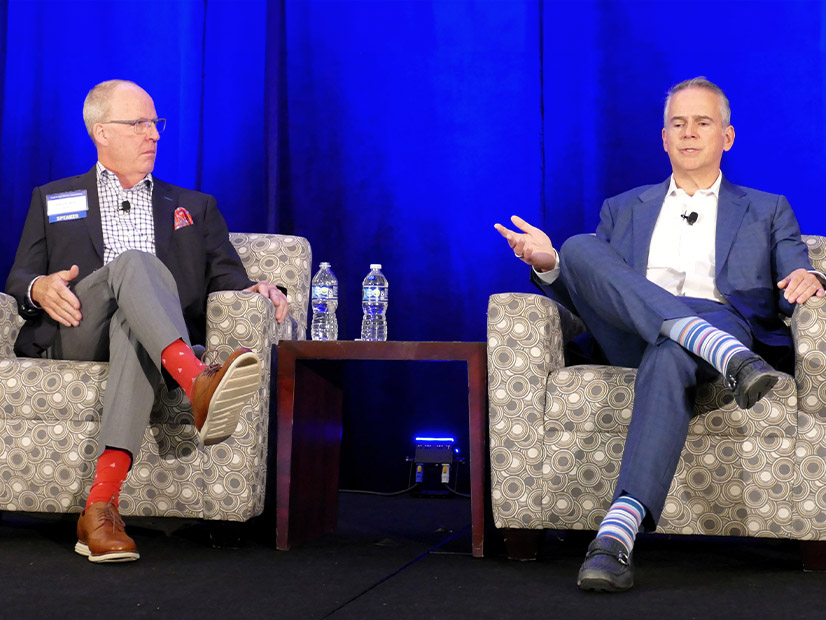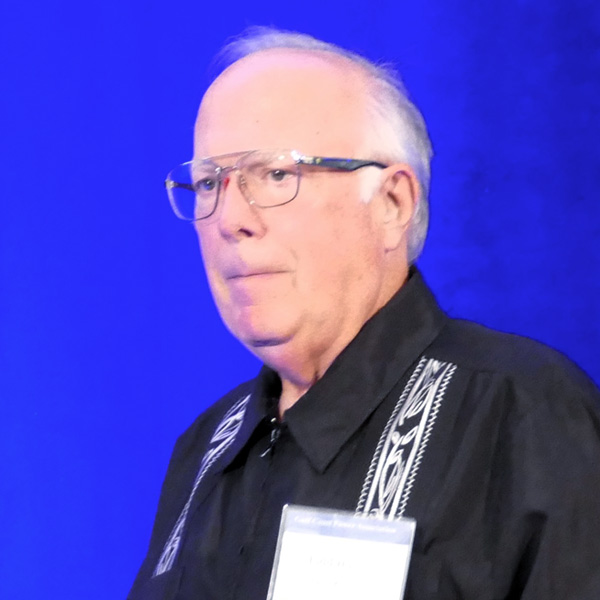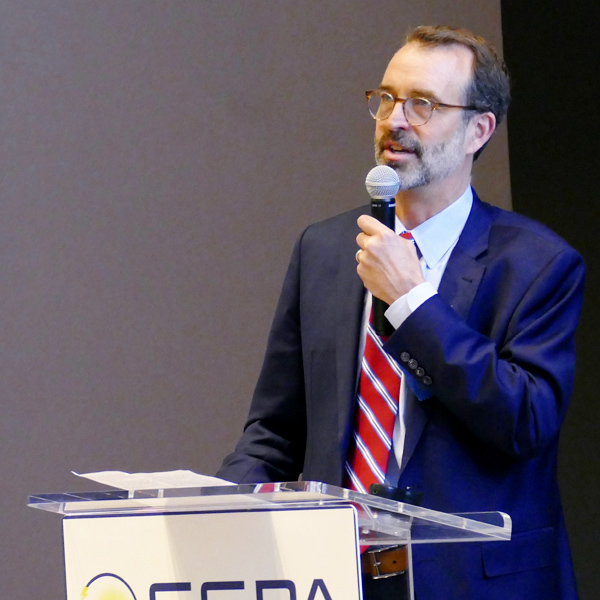AUSTIN, Texas — The Gulf Coast Power Association welcomed a record 829 attendees to its 38th annual Fall Conference, smashing the previous high of 766. They gathered Oct. 2-4 for discussions and vignettes on virtual power plants, resource adequacy, new technologies, grid resiliency, energy efficiency and demand response.
Stoic Energy’s Doug Lewin, introduced as “a man who has commandeered a cultlike following for his insight and passion for clean power and efficient solutions for greater reliability and resiliency” and a “voice of many too nervous to speak,” keynoted the conference’s second day and its focus on energy efficiency and residential demand response.
That has been Lewin’s north star since the disastrous 2021 winter storm that nearly brought down the ERCOT grid. A prolific user of the social network formerly known as Twitter, he has consistently espoused efficiency and residential demand response as answers to ERCOT’s difficulties in meeting soaring demand.
Armed with charts, graphs, news clips and data to bolster his point, Lewin asked, “How do we create a highly reliable grid at the least possible cost that will provide abundant and cheap power to as many people as possible?
“Texas has been focused on reliability for a while now, but affordability is also a key part piece of the puzzle,” he added. “Texas ranks last in energy burden, with nearly one out of every two Texans struggling to pay their electric bills. This needs attention and hopefully, each of us also agrees the solution must include creating a grid as clean as possible. Balancing reliability, affordability and sustainability … will create good-paying jobs, profits and wealth creation, tax base and economic growth. We stand to gain a huge share of investment wealth if we can show the world how to build a reliable, affordable and sustainable grid, and especially [if] we can center that grid on customers and strategies that empower them.”
The key, Lewin said, is shaving high loads by creating flexible demand where residential consumers can use less electricity when it’s scarce and more when it’s abundant.
“And they’ll get paid for it,” he said. “No more [ERCOT] conservation calls, which is nothing but a euphemism for uncompensated demand response.”
Lewin had an ally in Octopus Energy CEO Michael Lee. His electric retailer has more than 5 million customers in nine countries and says they can access affordable power during the transition to clean energy.
“As a load-serving entity, my ERCOT bill reflects when people use power, so we need to really shift away from thinking about megawatts,” he said. “We need to really think about customers. We have the opportunity of a lifetime to consumerize electricity. We should get creative and say how do we take costs out of the system and reward people for doing so. You have to consumerize it. You have to make it approachable.”
VPPs No Longer the ‘New Kid’
The pre-conference workshop on virtual power plants, “New Kid on the Block: Virtual Power Plants in ERCOT,” may have been a misleading title, its keynoter said.
“Distributed energy resources (DERs) that go into this concept of a virtual power plant are already here. It is not actually a new kid on the block. It is one of the oldest forms of how we supply power to ourselves,” Arushi Sharma Frank, senior counsel and U.S. energy markets policy lead for Tesla, said.
“The entire grid was distributed before we actually chose to centralize it, so we are actually going kind of back in time and forward [in] time at the same time,” she said. “The reason that these things are all showing up in droves without any particular market design or incentive to get them there is because people value losing load at a much higher dollar number than what the grid thinks they value.”
Frank vice-chaired an ERCOT pilot project that spent a year studying aggregated DERs and resulted in two VPPs qualified to provide dispatchable power to the state’s grid. Eight aggregations (ADERs), totaling 7.2 MW, participated in the pilot project. Two ADERs using Tesla Electric Powerwall storage systems have completed required testing and could provide energy and ancillary services through the third quarter. (See Texas Public Utility Commission Briefs: Aug. 24, 2023.)
As a consultant experienced with the “labyrinth of ERCOT systems,” Eric Goff was asked by Texas Public Utility Commissioner Will McAdams about the project’s operability.
“The fastest way to commercialize something new, the quicker you can actually make it happen,” Goff responded. “There are so many chicken-and-egg problems that having a laboratory to get things starting to commercialize was the fastest path forward. Now, that said, the pilot nomenclature and size can scare away some investment, so the sooner we can move towards permanent rules, the sooner we can get even more investment and even more participants on this program.”
That may not be easy. Aaron Berndt, head of energy industry partnerships for Google, said the main barrier to entry in ERCOT’s competitive market is the competitive market.
“It really is as simple as either [a] state or the utility saying, ‘We have got to come up with ways to fill this gap,’ and looking at my list of options to get there. If they’re in a state where it’s in their best interest to drive energy efficiency and demand response, they can just pile it up into big numbers to scale their program,” he said. “You could be scaling Texas energy efficiency programs and just make it easier for retailers to leverage the energy efficiency incentives and stats and use those to enroll them into their demand response program. Then they definitely have the ability to dispatch in a competitive market.”
McAdams offered his own counterpart: “$5,000 a is a hell of an incentive,” he said, referencing ERCOT’s systemwide cap price of $5,000/MWh during scarce operating conditions. “That’s every reason in the world where a consumer that has the means and capability and wherewithal, or even an apartment building, that wants to install the capability to avail themselves of this market.
“This is actually providing them a healthy return on investment. I want to get us past the stage where there are all these assertions that we were going to Californiaize the ADERs. We are all in this together … if we can solve the question of how to pay for system upgrades equitably as a systemwide cost, that goes hand in glove with this conversation about bringing more and more of these capabilities to market.”
Vegas Gives ERCOT an ‘A’ This Summer
Oncor Energy’s Brian Lloyd again displayed his off-beat skills in moderating panels when he opened a conversation with ERCOT CEO Pablo Vegas and MISO CEO John Bear by asking, “So, how was your summer?”
“It was a mix of ups and downs,” Vegas said, acknowledging 10 peak-demand records, multiple voluntary conservation calls, and one energy emergency alert. “Overall, I’m really thankful for the way the summer turned out. It was a great way to learn the capabilities of the organization. I am optimistic looking ahead, that summer should hopefully get a little bit easier.”
“I was asked a couple times what kind of grade I would give the performance,” he added. “I said, ‘Probably an A,’ and they’re like, ‘An A? How can you give an A with conservation calls and emergency conditions?’ I would say, ‘When you’re tested as hard as we were this summer and you pass it, you’ve got to give it an A.’”
Later turning to Bear, Lloyd asked, “Got any plans for the winter?”
Bear responded that he wouldn’t be hosting a holiday party, as he did last year for about 100 people on Christmas Eve. He said he spent the party sequestered in his study as Winter Storm Elliott swept through the Midwest.
“We talk a lot about summers, but the summer is a lot easier than the winter now, for all kinds of reasons and challenges we’re getting into as we get under our reserve margins,” Bear said. “So, how … we figure out the balance between the summer and the winter from the transmission and generation standpoint is going to be really important.
“We’re talking a lot about electrification like that’s the miracle that happens in 2030, right? There may be some slope in that curve, right? There’s a lot of manufacturing and offshoring and things like that going on that we hear about, but where are the assets that are going to provide that energy that businesses need?”
Vegas said the winter season is a “growing risk” for ERCOT, despite its status as a summer-peaking grid, but that the grid operator is taking steps to improve reliability.
“The winter peak is growing and getting closer to the summer peaks as there’s more electrification or conversion from gas to electric heating. Since Winter Storm Uri [in 2021], the whole mindset around the winter has really changed in Texas,” he said. “The weatherization program is fantastic … It has been effective, and it was proven to help significantly during Winter Storm Elliott. We have to prioritize where we’re investing our resources so that we can partner with the generator community and work together to make sure the resources are going to be reliable.”
State Rep Offers Advice
Texas state Rep. Todd Hunter (R), chair of the powerful State Affairs Committee, complimented the state’s electric sector for its response to the 2021 winter storm. Or “Snowcane Uri,” as he refers to the deadly event that sent temperatures below freezing in all 254 Texas counties.
“That’s rare. We can point the finger, blame everybody. What came out of it? Some new, developing legislation and communication,” he said.
Much of that legislation came through Hunter’s committee this year. He encouraged the audience to stop by his office and visit or keep him updated on the latest developments in the sector.
Citing one of the state’s transmission and distribution utilities, Hunter said, “They send me all sorts of texts, which is important for me to know. I’m talking to legislators and I’m talking to other people, so we have a flow of information. Legislators rely on me because that’s how I roll. When I know ya, I hear ya.”
Hunter, who prefers to wear only black and speaks in a country drawl, implored his audience to stay engaged with state lawmakers.
“The more you talk to us, the more we can help you. Most people don’t know what you do. They don’t know what a megawatt is. It sounds like a new burger from Whataburger,” he said. “We need power, water and labor. The economy is evolving and growing. We need laws that make sense.”
He pointed to the Harbor Bridge Project in his hometown, Corpus Christi — which he managed to mention 14 times — as a sign of Texas’ booming economy. The new bridge will enable more LNG exports from the city’s harbor. When complete, it will also be the tallest structure in South Texas and the longest cable stay bridge in the US.
“When you see this area, it’s like the unveiling of a portrait,” Hunter said. “Giant demand is coming. Whether you’re hydrogen or batteries, we already have stack-ups of different businesses coming into the area. That’s happening across Texas. Electricity is big.”
GCPA’s Casey to Retire
Saying he was both “proud and sad,” MD Energy Consulting’s Mark Dreyfus and the GCPA’s board president told attendees that Kim Casey has notified the directors she intends to retire next year.
“She entered this position with a passion for GCPA and she will depart us with that passion intact. I think that’s the best possible outcome for all of us,” Dreyfus said. As Casey stood uncomfortably next to him, he said, “Kim will be with us until June 1, so there will be plenty of time to honor and further embarrass her.”
“I’ve been coming to GCPA since 1996. I’ve not missed one single conference since then, so it’s been a pleasure to be part of this and to bring all of you together and it’s meant a lot to me,” Casey said after receiving a standing ovation. “Thank you to the board for your support and thanks to all of you.”
Casey was selected as GCPA’s fourth executive director in 2019, bringing more than 30 years of industry experience with her. Under her leadership, the organization survived the COVID-19 pandemic and now has more members than ever in its 40-year history.
Dreyfus said the board will conduct an open hiring process to find Casey’s replacement, with applications accepted through Nov. 15. The organization hopes to announce her successor during its annual spring conference, he said.
“We know that there are many talented participants in GCPA who have a passion for this organization and a great Rolodex, who may be interested in taking a different role,” Dreyfus said.
Octopus Energy’s Lee Honored
The GCPA honored Octopus Energy’s Lee with its annual emPOWERing Young Professionals award, which recognizes industry individuals under 40 years old who provide leadership and contribute to the success of their employer, the power market and the development of other industry professionals.
Lee has worked on some of the earliest energy storage projects and spent more than a decade in the renewables space. A Harvard graduate, he launched Evolve Energy, an energy retailer that focused on real-time index pricing paired with load-shaping automation software and later was acquired by Octopus, now valued at $5 billion. GCPA cited his use of technology to create “demand-centric solutions” for a more resilient grid.
“I would encourage everyone to think that this is not just an empowering young professional award, but also, as an industry, how do we empower disruptors?” Lee said. “We can continue doing what we’re doing and make things more expensive and what I think is probably less reliable, or we could do something new. We have incumbents who have established business models and the status quo. But we have disruptors that can do stuff faster, better and cheaper nipping at the heels. So how do we as an industry empower the disruptors?”














